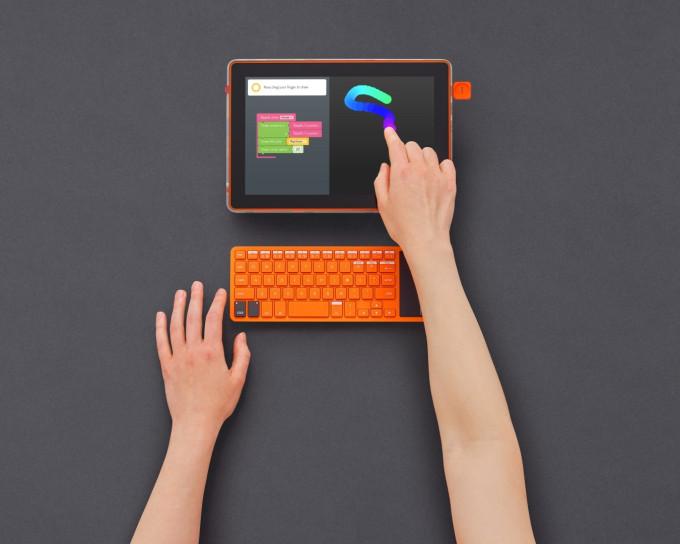Learn-to-code startup Kano, whose products aim to turn kids into digital makers, has taken the wraps off the latest incarnation of its build-it-yourself computer kit.
With the new flagship Kano is doubling down on touch interactions — urging kids to “make your own tablet”. The Computer Kit Touch packs a 10.1″ HD touchscreen, along with Kano’s now familiar bright orange wireless keyboard which comes with a built in trackpad.
While touch is becoming increasingly central to its products, Kano says the keyboard remains an important component of the product — supporting text-based coding apps which its platform also provides access to, as well as the more approachable drag-and-drop block-based coding systems that do really benefit from having a touchscreen to hand.
The kit, which Kano says is generally (but not exclusively) aimed at the 6-13 age range, is on sale from today, priced at $ 279.99 — via its website (Kano.me), as well as from selected retailers and e-tailers.
The Raspberry Pi powered computer is also getting increased storage capacity in this upgrade — of 16GB. But the main refresh is around updating Kano OS, Kano’s kid-friendly Pi topper, with expanded support for touch controls, according to founder Alex Klein .
Last year Kano combined touch and keyboard based interaction into a single product, the Computer Kit Complete — calling that a DIY laptop.
The 2018 refreshed version looks much the same, with enhancements generally behind the scenes and/or under the hood.

“The big moves this year are advancing the software and content ecosystem,” says Klein. “How it’s all integrated together.”
He points to another coding kit the team has up for pre-order, slated to ship next month — a co-branded Harry Potter gizmo in which kids get to build a motion-sensitive “coding wand” and use it to cook up their own digital spells, helped along by Kano’s software — adding: “With the Potter kit we’re bringing Kano code — to create a system, the ability to blend and change physics engines and sounds and particle systems — to tablets. So we’ve now got a touch-based interaction model for that e-product, as well as mouse and keyboard, and so we’ve brought that software system now to the Computer Kit Touch.
“You can code by dragging and dropping blocks with your fingers, you can paint and draw. You can change the pitch of a loop or a melody by running your fingers up and down and then using a change of a parameter mess with how quickly that melody changes, mess with the number of layers, you can make a beat or a loop using a touch-based digital audio workstation style X-Y plane. You can go into any one of our creative coding apps and pull in touch-based interactions, so instead of just using a mouse, a click and point, you can make an app that responds to swipes and taps, and different speeds, and in different locations.”
“On the touch kit itself there’s also a set of new content that demystifies how touchscreens work and peels back the layer of the screen and shows you what’s behind, and you’re kind of touching the intersection of the different copper wires and seeing what’s happening beneath,” he adds.
“There’s obviously a big hardware upgrade with the new ability to touch it, to take it with you. We’ve refined a lot of the components, we’ve improved the speed, the battery life. But really the core of it is this upgraded software that integrates with all the other kit.”
Talking of other kit, the learn-to-code space is now awash with quasi-educational gizmos, leaving parents in Western markets spoiled for choice of what to buy a budding coder.
Many more of these gizmos will be unboxed as we head into the holiday season. And while Kano was something of a startup pioneer here — a category creator, as Klein tells it — there’s now no shortage of tech for kids promising some kind of STEM-based educational benefit. So it’s facing an ever-growing gaggle of competition.
Kano’s strategy to stand out in an increasingly contested space is to fix on familiar elements, says Stein — flagging for example the popular game Minecraft — which runs on the Kano kit, and for which there’s a whole subsection of the Kano World community given over to hacking Minecraft.
And, well, aside from block-headed Minecraft characters it’s hard to find a character more familiar to children than the fictional wizard Harry Potter. So you can certainly see where Kano’s trying to get with the coding wand.
“We broke our first month pre-order target in one day,” he says of that forthcoming e-product (RRP ~$ 130). “There was massive coverage, massive traffic on our site, it was picked up all over the place and we’re very happy with the pre-orders so far. As are our retail partners.”
The Potter co-branding play is certainly Kano trying to make its products cast a wider spell by expanding the appeal of coding from nerdy makers to more mainstream child consumers. But how successful that will be remains to be seen. Not least because we’ve seen this sort of tactic elsewhere in this space.
Sphero, for example, is now rolling back the other way — shifting away from Star Wars co-branded bots to a serious education push focused on bringing STEM robotics to schools. (Although Kano would doubtless say a programmable bot that rolls is not the same as a fully fledged kit computer that can run all manner of apps, including familiar and fashionable stuff like Minecraft and YouTube.)
“We’re very pleased to see that this category that we created, with that Kickstarter campaign in 2013 — it’s become more than what some people initially feared it would be which was niche, maker ‘arcanery’; and it’s becoming a major consumer phenomenon,” he says. “This notion that people want to make their own technology, learn how to code and play in that way. And not just kids — people of all ages.”
On the hard sales front, Klein isn’t breaking out numbers for Potter kit pre-sales at this stage. But says the various incarnations of its main computer kit have shipped ~360,000 units since September 2014. So it’s not Lego (which has also moved into programmable kits) — but it’s not bad either.
In recent years Kano has also branched out into offering Internet of Things kits, previewing three code-your-own connected devices in 2016 — and launching Kickstarter campaigns to get the products to market.
It’s since shipped one (the Pixel kit) but the other two (a build-it-yourself camera kit and a DIY speaker) remain delayed — leaving crowdfunder backers waiting for their hardware.
Why the delay? Have Kano’s priorities shifted — perhaps because it’s focusing efforts on cobranded products (like the Potter wand) vs creating more of its own standalone devices?
“We are still committed to shipping the speaker kit, the camera kit,” Klein tells TechCrunch. “A big reason for [the delay] is not only the fact that the company is in a position now where we have mass distribution, we have great partners — perennially testing new product ideas — and we want to make sure that products are going to resonate with, not just a small group of people but many, many people, of many different age groups and interests before we release them.”
He also points out that any backers of the two devices who want refunds can get them in full.
Though he also says some are choosing to wait — adding that Kano remains committed to shipping the devices, and saying for those that do wait there will be a few extra bells and whistles than originally specced out in the crowdfunder campaign.
The delay itself looks like the market (and consumer tastes) moving quicker than Kano predicted — and so it finds itself wishing its products could deliver more than it originally planned (but without a wand to wave to instantly achieve that).
This is also a pitfall with previewing anything months or years ahead of time, of course. But the expense and complexity of building hardware makes crowdfunding platforms attractive — even for a relatively established brand like Kano.
“The delay is really unfortunate,” he adds. “We did say they would ship earlier but what we have done is we’ve offered any backer a full refund on the camera and the speaker if they don’t want to wait. But if they do wait they will receive incredible camera, incredible speaker. Both of them are going to benefit from the advancements made in low cost computing in the last year.
“The speaker as well is going to have elements that weren’t even part of the original campaign. On our side it’s critical that we get those products absolutely right and that they feel mass, and that they demystify not only coding and the Internet of Things, which was part of the original purpose, but in the case of the camera and the speaker there are elements that have come to the fore in more recent months like voice interaction and image recognition that we feel if our mandate is to demystify technology and we’re shipping a camera and a speaker… that’s kind of part of it. Make it perfect, make it of the moment. And for any backer who doesn’t want to wait for that, no problem at all — we’ll refund you 100%.”
Beyond reworking its approach with those perhaps overly ambitious connected devices, Kano has additional release plans in its pipeline — with Klein mentioning that additional co-branded products will be coming next year.
He says Kano is also eyeing expanding into more markets. “There’s a significant market for Kano even beyond our traditional leading position amongst 6-13 year olds in the US and the UK. There’s a really strong market for people who are beyond the US and the UK and we’re now at a scale where we can start really investing in these distribution and localization relationships that have come our way since year one,” he says.
And he at least entertains the idea of a future Kano device that does away with a keyboard entirely — and goes all in on touch — when we suggest it.
“Would we move to a place where we have no keyboard in a Kano computer? I think it’s very possible,” he says. “It might be a different form factor, it might be smaller, it might fit in your pocket, it might have connectivity — that kind of stuff.”
Which sort of sounds like Kano’s thinking about making a DIY smartphone. If so, you heard it here first.
The five and a half year old London-based startup is not yet profitable but Klein flags growth he dubs “fast enough” (noting it doubled sales year-over-year last year, a “trend” he says continued in the first half of this year), before adding: “It’s not impossible for us to get to profitability. We have a lot of optionality. But at the moment we are making investments — in software, in team — we have partner products coming out like Harry, we’ll have more coming out next year. So in terms of absolute positive EBITDA not yet but we are profitable on a units basis.”
Kano closed a $ 28M Series B last year — and has raised some $ 44.5M in all at this stage, according to Crunchbase. Is it raising more funding now? “I think any entrepreneur who is looking to do something big is always in some sense keeping an eye out for sources of capital,” replies Klein. “As well as sources of talent.”
He points by way of a connected aside to this study of C-suite execs, carried out by Stripe and Harris poll, which found that access to software developers is a bigger constraint than access to capital, saying: “I read that and I thought that that gap — between the 1% of 1% who can develop software or hardware and the rest of us — is exactly the challenge that Kano set out to solve from a consumer and education perspective.”
“In terms of fundraising we do get a lot of inbound, we have great investors at the moment,” he adds. “We do know that the scale of this particular challenge — which is demystify technology, become synonymous with learning to code and making your own computers — that requires significant support and we’ll be continuing to keep our eyes out as we grow.”




























